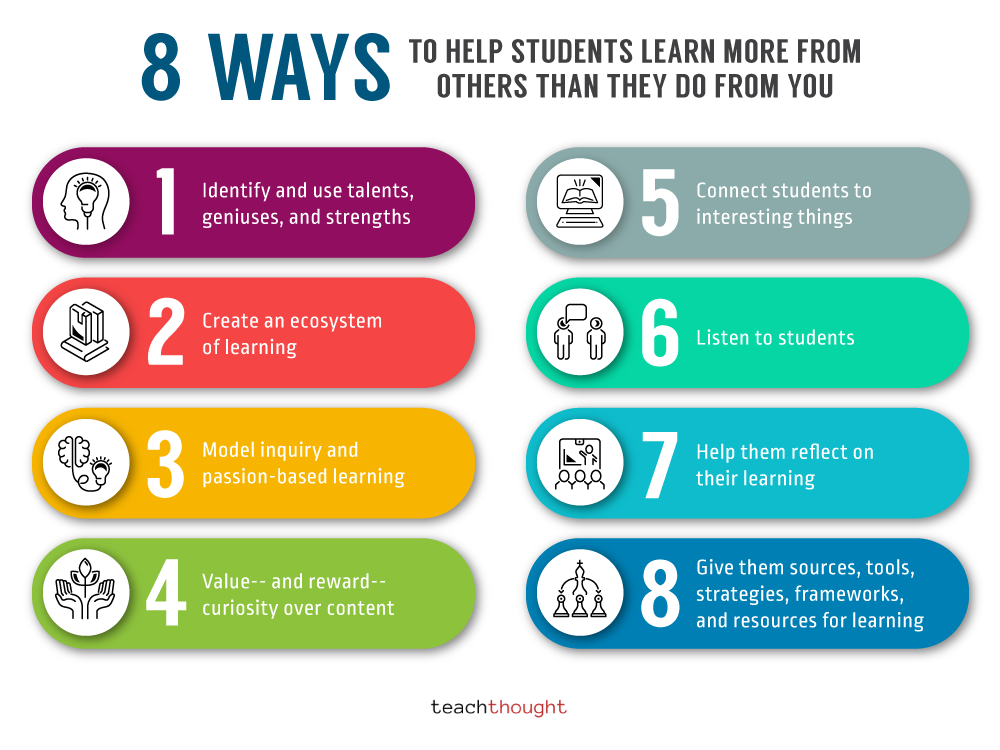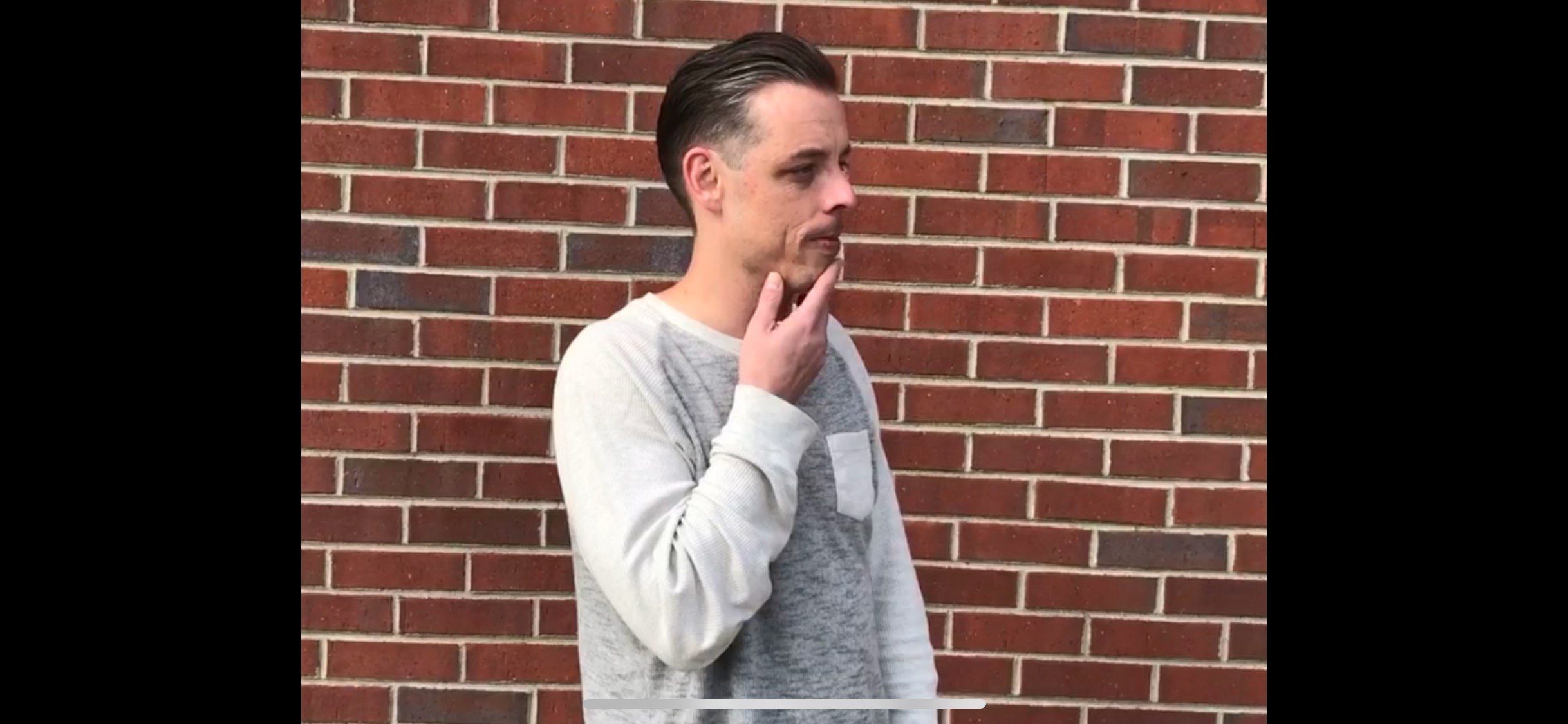
10 Ways To Help Students Learn More From Others Than They Do From You
by Terrell Heick
Who controls the learning in your classroom?
What are the sources of that learning? Does the learning happen as a matter of access to content, or participation in teacher-derived learning activities–i.e., units and lessons? Who or what is the most persistent catalyst in the process of learning?
Frequently, it’s probably you (the teacher). You’re the expert on both content and pedagogy. You know what’s being learned and how it might be best learned. Giving students full autonomy in their own learning might be fine for motivation, but that can be a problem for various reasons. Despite their extraordinary effort, any teacher is inherently finite. Limited. The teacher also has ‘self-bias’–sees things from their point-of-view no matter how hard they try. In a teacher-centered classroom, the teacher is the bottleneck. (Here are a few examples of student-centered learning.)
This suggests connecting them to other people, platforms, and communities, and that’s part of the answer. But it’s not that simple. This means that the kinds of ‘imbalances’ are important to recognize. If a student has begun a project researching and publishing their family tree and runs into problems, what are their habits? How do they respond? As an educator, this is a matter that is both practical (in terms of the practice of teaching), and emotional (in terms of how you relate to students). Teaching and learning are naturally imbalanced processes. That is, they tend to elevate one side (in Vygotsky’s language, the More Knowledgeable Other) to a position of authority, while the other becomes submissive. Or at least needy.
Traditionally, the ‘MK’ has been the teacher, and the ‘LK’ (Less Knowledgeable) the student. The fact that the teacher also manages the discipline and workflow of the classrooms makes it all the more convenient and even invisible. In connectivist learning models and environments (assuming you use them), it may not be a teacher. It could be a mentor, community member, or expert. In a peer-to-peer or school-to-school learning model, it may not even be an adult. This suggests some tweaks in how teaching–and learning–happen.
How To Help Students Learn From Anything: 8 Ways To Help Students Learn More From Others Than They Do From You
1. Identify talents, geniuses, and strengths (t/g/s): First and foremost, identify the inherent strengths and natural aptitudes of students. And in a theme you’ll see continued below, help them identify them for themselves…
- Examples of their talents, geniuses, and strengths (t/g/s)
- Attributes of their t/g/s
- Sources of their t/g/s
- Effects of their t/g/s
- Potential uses of their t/g/s
2. Create an ecosystem of learning: Connect students to one another through those talents, geniuses, strengths, or even characteristics about themselves they value (e.g., affections). Whether it’s creative (e.g., painting), specific knowledge (e.g., advanced understanding of math), skill-based (e.g., athletics, music, etc.), geography-based (e.g., rural learners connecting to other rural learners–or the opposite, rural to urban and vice-versa), connecting students.
And note, this doesn’t mean that students that ‘draw well’ should go hang out with other students that ‘draw well.’ Though that’s possible, it also could be that the student that ‘draws well’ connect with a student that ‘codes well’ and another student that ‘plays the violin well’ to identify shared opportunities to grow as individuals–and create a better world in the process. The big idea here is sustainability by creating an ecosystem of learning based on creativity, interest, and possibility as brought to bear by students on topics, problems, and opportunities they care about.
3. Model passion-based learning: How to ask great questions, how to think critically about topics, and how to use human passion and curiosity to sustain inquiry over time that results in lifelong learning and human growth.
4. Value (& reward) curiosity over content: Are you teaching content or teaching thought? This is an important distinction that changes everything. And in parallel, are you valuing content mastery over curiosity? True, they needn’t be mutually exclusive, but by design, what are you trying to achieve, and what can you point to as proof that it’s truly ‘by design’?
This concept can go both ways–interesting content can promote curiosity as much as curiosity can lead to interesting content. But big picture, curiosity is a strategy and framework for knowledge and application of knowledge, while knowledge itself is inert without the former. Here are some ideas for helping students learn to ask great questions.
5. Connect learners to interesting things: Get out of the way. The world is an amazing place–a lot of the ‘learning from anything’ and ‘learning more from other people than they do from you’ can be reduced to uncovering cool things (bridge design, brain surgery, agrarian principles, etc.), and then only stepping in when you see they need ‘something’ (see #8 below).
And once you’ve done so, don’t ‘school it up’ with a bunch of meaningless work and letter grades, or you’re defeating the whole purpose of creating learners that manage themselves, learn for themselves, and direct their own truly personalized learning pathways. See also Why What Students Don’t Know Is More Important Than What They Do.
6. Help learners see that everyone has something to teach: This can happen by studying people in ‘non-traditional’ ways and for ‘non-traditional’ reasons. Understanding other people can increase empathy, but it also can provide a growth model. Biographies can be useful here, but helping them create biographies of their own is even better because it helps the learner frame the subject through a lens that makes sense to and interests them. For example, rather than reading a glossy biography that provides an overview of a life, where they were born and raised, and maybe identifying a challenge the person had to overcome, students instead might study someone–one of ‘the greats’– who exemplify specific characteristics, contexts, or virtues that resonate with the student.
Maybe Michael Jordan doesn’t ‘resonate’ with a modern student who never got to see the basketball great in his prime, but examining Jordan through the lens of sacrifice–how he cut the webbing between his fingers so that he could palm a basketball, or retired from basketball at the peak of his abilities to pursue a baseball career after the death of his father–is more authentic and more useful. It also allows students to learn something from everyone, providing a method of examining even deeply flawed individuals to extract lessons, learn from mistakes, etc.
Muhammad Ali, John F. Kennedy, Wendell Berry, Lebron James, their mother or father or one of their grandparents. A soldier or farmer or entertainer. A major or obscure historical figure or musician. These are the kinds of people that have credibility with young learners. Helping learners examine people through certain lenses–warts and all–can help them create a fuller picture of who–and ‘what’–they’re trying to become looks like.
7. Help them reflect on their learning: Help students reflect on what they’ve learned, how they’ve grown, how others are learning and growing, who they’re connected to and how, etc. You might start with 8 Reflective Questions To Help Any Student Think About Their Learning. Reflection is crucial to learning for various reasons, including how it can help illuminate growth and opportunities for learners that they otherwise may have missed, taken for granted, misunderstood, failed to appreciate, etc.
8. Give them sources, tools, strategies, frameworks, and resources for learning: I could go on and on with a list like this, but I’m already approaching 1200 words, so I’ll end with this one. No matter the interesting topics, illuminated gifts, shared interdependence, afforded opportunities, compelling biographical models, etc.–without ways and means and methods of practicing and documenting learning, progress can be slow. Whether it’s a book, app, athletic team, video game, organizational membership, paintbrush, laptop, writer’s desk, blog, garden, sewing machine–or even less-tangible things like encouragement, schedules, to-do lists, etc.–the ‘ecosystem’ of learning we talked about earlier could lack the catalysts to maintain growth over time.
9. Use mentoring–and not just adults and not just for ‘careers’: This one is a little redundant, but the distinction here is not just to allow students to connect with other students (like #2) or ‘study people’ (like #6), nor even follow professionals from a specific field to get ‘career advice,’ but rather to connect different people of different age and social groups for different reasons to have different experiences that enrich their cultural and human context: Who they are, who they are connected to, and what that connection requires and suggests.
10. Help them define quality for themselves: Otherwise, they can be trained to look for external validation for the rest of their lives, seeking to be told they’re ‘good at’ something rather than wanting and learning to become ‘good at’ things for more powerful and enduring reasons.
